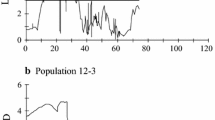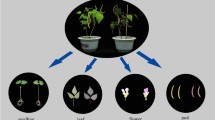Abstract
A genetic locus, Anp, controls anthocyanin accumulation in the epidermal cell layers of bean (Phaseo-lus vulgaris L.) pods and pulvini, and in the standard petals of bean flowers. The expression of the Anp-dependent phenotype requires normal purple pigmentation of the hypocotyl and of the cotyledons. In the Anp-deficient bean genotype, La Victoire, the mRNA transcripts of chalcone synthase and chalcone isomerase accumulated to levels comparable to those of the Anp-carrying genotype AFN. The two genotypes had similar amounts of chalcone synthase enzyme in the epidermal cells where anthocyanins are accumulated in AFN, as shown by immunocytolocalization. The genotype La Victoire accumulated low levels of flavones, flavonols and proanthocyanins but absolutely no anthocyanins in the organs in which pigmentation is controlled by Anp. The data indicate that Anp represents a locus involved in the organ-specific expression of the late steps of the anthocyanin pathway.
Similar content being viewed by others
Abbreviations
- CHI:
-
chalcone isomerase
- CHS:
-
chalcone synthase
- LV:
-
La Victoire
- UFGT:
-
uridine flavonoid 3-O-glucosyl transferase
References
Almeida, J., Carpenter, R., Robbins, T.P., Martin, C., Coen, E.S. (1989) Genetic interactions underlying flower colour pattern in Antirrhinum majus. Genes Dev. 3, 1758–1767
Alonso, E., Revilla, E., Bourzeix, M., Heredia, N. (1989) An improved method for determination of catechins and procyanidins in wines. In: Impact of technology on food quality and quality assurance, agriculture, food chemistry and the consumer (Proc. 5th European Conf. Food Chemistry, 2), pp. 684–688, INRA, Paris
Axelos, M., Bardet, C., Liboz, T., Le Van Thai, A., Curie, C., Lescure, B. (1989) The gene family encoding the Arabidopsis thaliana translation elongation factor EF1-α: molecular cloning, characterisation and expression. Mol. Gen. Genet. 219, 106–112
Bell, J.N., Ryder, T.B., Wingate, P.M., Bailey, J.A., Lamb, C.J. (1986) Differential accumulation of plant defense gene transcripts in a compatible and an incompatible plant-pathogen interaction. Mol. Cell. Biol. 6, 1615–1623
Bradford, M. (1976) A rapid and sensitive method for the quantification of microgram quantities of protein utilizing the principle of protein dye binding. Anal. Biochem. 72, 248–254
Chandler, W.L., Radilella, J.P., Robbins, T.P., Chen, J., Turks, D. (1989) Two regulatory genes of the maize anthocyanin pathway are homologous: isolation of B utilizing R genomic sequences. Plant Cell 1, 1175–1183
Cone, K.C., Burr, F.A., Burr, B. (1986) Molecular analysis of the maize anthocyanin regulatory locus C1. Proc. Natl. Acad. Sci. USA 83, 9631–9635
Consonni, G., Racchi, M.L., Shammah, S., Gavazzi, G.A. (1987) The role of Sn in the light regulated activity of enzymes of flavonoid biosynthesis. Maize Genet. Coop. Newsl. 61, 75
Cramer, C.L., Edwards, K., Dron, M., Liang, X., Dildine, S.L., Bolwell G.P., Dixon, R.A., Lamb, C.J., Schuch, W., (1989) Pheny-lalanine ammonia-lyase gene organization and structure. Plant Mol. Biol. 12, 367–383
Dellaporta, S.L., Greenblatt, I., Kermicle, J.L., Hicks, J.B., Wessler, S.R. (1988) Molecular cloning of the maize R-nj allele by transposon tagging with Ac. In: Chromosome structure and function, pp. 263–282, Gustafson, J.P., Appels, R., eds Plenum, New York
Edwards, K., Cramer, C.L., Bolwell, G., Dixon, R.A., Schuch, W. (1985) Rapid transient induction of phenylalanine ammonialyase mRNA in elicitor-treated bean cells. Proc. Natl. Acad. Sci. USA 82, 6731–6735
Gantet, P. (1992) Caractérisation d'Anp, un gène impliqué dans l'accumulation organe-spécifique des anthocyanes chez le haricot (Phaseolus vulgaris L.) et génétiquement lié au gène Mex2 de résistance à l'anthracnose. Thèse de Doctorat, Université Paris XI, France
Gantet, P., Bettini, P., Grisvard, J., Dron, M. (1991) Genetic linkage between Mex2, a specific resistance gene to anthracnose, and Anp, a gene involved in pod anthocyanin accumulation in bean. Plant Disease 75, 941–942
Gerats, A.G.M., Wallroth, M., Donker-Koopman, W., Groot, S.P.C., Schram, A.W. (1983) The genetic control of the enzyme UDP-glucose: 3-O-flavonoïd-glucosyltranferase in flowers of Petunia hybrida. Theor. Appl. Genet. 65, 349–352
Goodrich, J., Carpenter, R., Coen, E.S. (1992) A common gene regulates pigmentation pattern in diverse plant species. Cell 68, 955–964
Grotewold, E., Athma, P., Peterson, T. (1991) Alternatively spliced products of the maize P gene encode proteins with homology to the DNA-binding domain of myb-like transcription factors. Proc. Natl. Acad. Sci. USA 88, 7092–7096
Heller, W., Forkmann, G. (1988) Biosynthesis. In: The flavonoids, advances in research since 1980, pp. 399–425, Harborne, J.B., ed. Chapman and Hall, London
Hrazdina, G., Marx, G.A., Hoch, H.C. (1982) Distribution of secondary metabolites and their biosynthetic enzymes in pea (Pisum sativum) leaves. Plant Physiol. 70, 745–748
Jackson, D., Roberts, K., Martin, C. (1992) Temporal and spatial control of anthocyanin biosynthetic genes in developing flowers of Antirrhinum majus. Plant J. 4, 425–434
Jonsson, L.M.V., Aarsman, M.E.G., Bastiannet, J., Donker-Koupman W.E., Gerats, A.G.M., Schram, A.W., (1984a) Common identity of UDP-Glucose anthocyanidin 3-O Glucosyl transferase and UDP-Glucose Flavonol 3-O Glucosyl transferase in flowers of Petunia hybrida. Z. Naturforsch. 39c, 556–567
Jonsson, L.M.V., Donker-Koopman, W.E., Schram, A.W. (1984b) Turnover of anthocyanins and tissue compartmentation of anthocyanin biosynthesis in flowers of Petunia hybrida. J. Plant Physiol. 115, 29–37
Koes, R.E., van Blokland, R., Quattrocchio, F., van Tunen, A.J., Mol, J.N.M. (1990) Chalcone synthase promoters in petunia are active in pigmented and unpigmented cell types. Plant Cell 2, 379–392
Leakey, C.L.A. (1988) Genotypic and phenotypic markers in common bean. In: Common beans: research for crop improvement, pp. 245–327, Van Schoonhover, A., Voysest, B., eds. C.A.B. international, CIAT, Colombia
Ludwig, S.R., Wessler, S.R. (1990) Maize R gene family: tissue-specific helix-loop-helix proteins. Cell 62, 849–851
Ludwig, S.R., Habera, L.F., Dellaporta, S.L., Wessler, S.R. (1989) Lc, a member of the maize R gene family responsible for tissue-specific anthocyanin production, encodes a protein similar to a transcriptional activator and contains the myc-homology region. Proc. Natl. Acad. Sci. USA 86, 7092–7096
Mahé, A., Grisvard, J., Dron, M. (1992) Fungal and plant specific gene markers to follow the bean anthracnose infection process and normalize a bean chitinase mRNA. Mol. Plant Microbe Interact. 5, 242–248
Martin, C., Prescott, A., Mackay, S., Bartlett, J., Vrijlandt, E. (1991) Control of anthocyanin biosynthesis in flowers of Antirrhinum majus. Plant J. 1, 37–49
Mehdy, M.C., Lamb, C.J. (1987) Chalcone isomerase cDNA cloning and mRNA induction by fungal elicitor, wounding and infection. EMBO J. 6, 1527–1533
Menssen, A., Hömmann, S., Martin, W, Schanle, P.S., Peterson, P.A., Saedler, H., Gierl, A. (1990) The En/Spm transposable element of Zea mays contains splice sites at the termini generating a novel intron from a dSpm element in the A2 gene. EMBO J. 9, 3051–3058
Mullick, D.B. (1969) Thin layer chromatography of anthocyanidins. 1) Techniques and solvents for two-dimensional chromatography. J. Chromatogr. 39, 291–298
Paz-Ares, J., Ghosal, D., Wienand, U., Peterson, P.A., Saedler, H. (1987) The regulatory c1 locus of Zea mays encodes a protein with homology to myb proto-oncogene products and with structural similarities to transcriptional activators. EMBO J. 6, 3553–3558
Ribereau-Gayon, P. (1968) Méthodes générales d'étude des composés phénoliques. In: Les composés phénoliques des végétaux, pp. 59–85, Dunod, ed. Aubin, Paris
Ryder, T.B., Hedrick, S.A., Bell, J.N., Liang, X., Clouse, S.D., Lamb, C.J. (1987) Organization and differential activation of a gene family encoding the plant defense enzyme chalcone synthase in Phaseolus vulgaris. Mol. Gen. Genet. 210, 219–233
Schmelzer, E., Jahnen, W, Hahlbrock, K. (1988) In situ localization of light induced chalcone synthase mRNA, chalcone synthase, and flavonoid end products in epidermal cells of parsley leaves. Proc. Natl. Acad. Sci. USA 85, 2989–2993
Schmid, J., Doerner, P.W., Clouse, S.D., Dixon, R.A., Lamb, C.J. (1990) Developmental and environmental regulation of a bean chalcone synthase promoter in transgenic tobacco. Plant Cell 2, 619–631
Taylor, L.P., Briggs, W.R. (1990) Genetic regulation and photocontrol of anthocyanin accumulation in maize seedlings. Plant Cell 2, 115–127
Tonelli, C., Consonni, G., Dolfini, S.F., Dellaporta, S.L., Viotti, A., Gavazzi, G. (1991) Genetic and molecular analysis of Sn, a light-inducible, tissue specific regulatory gene in maize. Mol. Gen. Genet. 225, 401–410
van der Meer, I.M. (1991) Regulation of flavonoid gene expression in Petunia hybrida: cis-acting elements and trans-cting factors. Ph.D. thesis, Vrije Universiteit te Amsterdam, The Netherlands
van Tunen, A.J., Mol, J.N.M. (1990) Control of flavonoid biosynthesis and manipulation of flower color. In: Plant biotechnology series, pp. 94–130, Grierson, D., ed. Blackie and Son Ltd., Glasgow
van Tunen, A.J., Mur, L.A., Brouns, G.S., Rienstra, J.D., Koes, R.E., Mol, J.N.M. (1990) Pollen and anther-specific chi promoters from petunia: tandem promoter regulation of the chiA gene. Plant Cell 2, 293–401
van Tunen A.J., Mur, L.A., Recourt, K., Gerats, A.G.M., Mol, J.N.M., (1991) Regulation and manipulation of flavonoid gene expression in anthers of petunia: the molecular basis of the Po mutation. Plant Cell 3, 39–48
Wienand, U., Scheffler, B., Franken, P., Schrell, A., Niesbach-Klösgen U., Tapp, E., Paz-Ares, J., Saedler, H., (1991) Molecular analysis of anthocyanin genes of Zea mays. In: Plant molecular biology 2, pp. 747–755, Herrmann, R.G., Larkins, B., eds. Plenum Press, New York
Author information
Authors and Affiliations
Additional information
P.G. was supported by a pregraduate fellowship from the ORSAN company. We thank M. Bourzeix (INRA, Narbone, France) for help with proanthocyanins analysis, S. Brown (CNRS, Gif sur Yvette, France) for providing microscopic facilities, A. Trémolières and B. Pinaud (CNRS, Gif sur Yvette) for HPLC facilities. The help of J-P. Renaudin in preparation of the manuscript was greatly appreciated.
Rights and permissions
About this article
Cite this article
Gantet, P., Brangeon, J., Grisvard, J. et al. Anp, a genetic locus controlling organ-specific accumulation of anthocyanins in Phaseolus vulgaris L.. Planta 190, 459–467 (1993). https://doi.org/10.1007/BF00224784
Received:
Accepted:
Issue Date:
DOI: https://doi.org/10.1007/BF00224784




